Key:obstacle
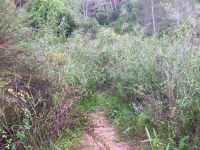 |
| Description |
|---|
| Objective obstacles in a path (or highways) that difficult the passability. |
| Group: properties |
| Used on these elements |
| See also |
| Status: in use |
| Tools for this tag |
|
|
This is not a voted feature, the page documents actual usage and advices suggested use. It is incorporating information from a related (and seemingly abandoned) proposal. |
The goal of this tag is to mark obstacles which are not derived from the properties of the road (surface, material, width, etc.) but from its environment or local properties; similarly, marks places where a way (most often waterways) have environmental obstacles. This tag can be used in a navigation application to avoid areas or use parts of the road with lower priorities when calculate routes, similarly to bumps, ferries or non-free roads, but it can be used on paths for non-vehicles.
This key is also used by Humanitarian OSM Team.
See also the more common key barrier=*, used to map single barrier points on roads and paths, including logs, blocks, debris and ditches.
Tagging
|
Use only on already existing barrier=* key. |
This key has been proposed, but the most frequently used values are not covered by the proposal. Please help document what these values mean and where they come from.
General use
| Value | Usage | Count | Meaning | Alternatives | Ways | Project | Image |
|---|---|---|---|---|---|---|---|
| vegetation |
|
Movement on route is hard due to overgrown vegetation (shubs, dense grass, nettle, lianas etc.), movement is significantly slowed down or you have to move carefully. | highway | General | 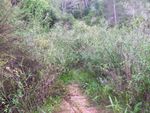
| ||
| fallen_tree |
|
There are multiple fallen trees (lumber) along a way, usually a path, that severely or completely hinder passability and you can only continue along the path if you somehow bypass them (above, below, or detour around them). For a single tree, it is suggested to use barrier=log instead.
|
See #Fallen tree below. | highway | General | 
| |
| unevenness |
|
To follow the trail you must use hands and it cannot be avoided. | see discussion | highway | General | 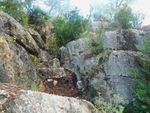
| |
| precipice |
|
There is an important precipice alongside the trail (at least one side) that your eyes can't avoid see if you look forward and you see the falling. There are a minimal risk of falling, but it's an important difficulty for people with dizziness. You can't move over away from the precipice and take out it of your visual field. | highway | General | 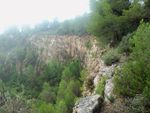
| ||
| heap |
|
There is a large heap of material (soil, rock pile, rubbish heap, etc.) making the movement difficult. | highway | General | 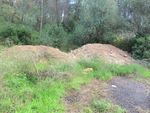
| ||
| hole |
|
There is a large hole or holes on the road making the movement difficult or dangerous by smaller vehicles. | highway | General | 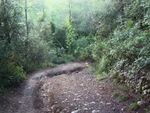
| ||
| yes |
|
undefined (or "other") environmental factors make moving on the route difficult | use a more specific tag | highway | General |
OpenSeaMap use (obsolete)
| Value | Usage | Count | Meaning | Alternatives | Ways | Project | Image |
|---|---|---|---|---|---|---|---|
| bridge | 2320 | (Old tagging scheme not used by OpenSeaMap) | ? | waterway | OpenSeaMap | ||
| lock | 695 | (Old tagging scheme not used by OpenSeaMap) | lock=*, waterway=lock_gate
|
waterway | OpenSeaMap | ||
| ? | (Old tagging scheme not used by OpenSeaMap) | barrier=* + access=no
| |||||
| line | 476 | (Old tagging scheme not used by OpenSeaMap) | ? | waterway | OpenSeaMap | ||
| ferry | ? | 44 | (Old tagging scheme not used by OpenSeaMap) | route=ferry
|
waterway | OpenSeaMap | |
| drawbridge | 24 | (Old tagging scheme not used by OpenSeaMap) | bridge:movable=drawbridge
|
waterway | OpenSeaMap | ||
| tunnel | 24 | (Old tagging scheme not used by OpenSeaMap) | tunnel=*
|
waterway | OpenSeaMap |
Description
If you use the obstacle=* you can give more details about it by using
| Count | Key | Value |
|---|---|---|
|
|
obstacle_description=*
|
The short and precise description of the obstacle (eg. "nettle", "dug hole", "rubbish" [heap]) |
Related tags
barrier=*- more common key for barriers including logs, ditches, debris, etc.highway=*surface=*smoothness=*width=*maxheight:physical=*(maxheight=*is the highest permitted vehicle height, andheight=*is the height of an object!)trail_visibility=*sac_scale=*tracktype=*
Specific cases
For various point-like obstruction features you should check barrier=* first: the key often contains both individual objects (like a wall) or independent environmental barriers (like a log), and may be more widely used than using obstacle=*.
You cannot use barrier=* for longer segments of a way obstructed by the environment: for that purpose obstacle=* may be a better fit (unless you intend to map all obstacles individually).
Fallen tree
For a single fallen tree you should use a barrier=log node.
obstacle=fallen_tree tagging is more fitting to a way continuously obstructed by a large number of fallen trees (for example, an uncleared narrow valley road).
If it's a tree which could be used as a way (bridge) please use highway=path + surface=wood (and optionally bridge=yes) instead.
Do not use this tagging on "fresh" or temporary fallen trees, unless you can reasonably expect them to stay uncleared for years to come. The tagging implies that the trees remain there for years and will not be cleaned up (or cut) soon. This may or may not be obvious or even possible to determine without local knowledge, especially with a single survey. It is common for various trails and tracks to get obstructed after major storms, landslides or other events, and it may take authorities, such as emergency or forestry operators, many months to clear these. In contrast, if damage is not cleared on some ways but cleared elsewhere nearby, it may indicate that such ways are not official or maintained and may not get cleared at all (for example, a forestry operator may clear debris from forest access tracks, but not necessarily from cutlines/fire breaks).
Hole and heap
These are usually nodes. It is possible that a large hole or heap have a size beyond 5 meters and could be tagged on a way; avoid tagging it as an area because it would make it nearly impossible to use for navigational applications. (A 10 meter hole or heap technically make the road disappear and people usually expected to go around it, creating a new path without hole or heap.)
Please also consider the tags hazard=hole, hazard=bump.
Temporary obstacle
It is possible to record the periodic, regular obstruction by using conditional restrictions. For example in the case of an overgrown road during vegetational season:
but this is usually redundant if it logically infers from the key (vegetation almost always grow from spring to autumn).
If a road is infrequently or irregularly cleared then the intermittent=yes notation also can be used.
See also
barrier=*- A barrier is a physical structure which blocks or impedes movement. This key is more commonovergrown=*- Indicates that a feature, usually a highway, is overgrown with vegetation.hazard=hole(and potentially otherhazard=*values)